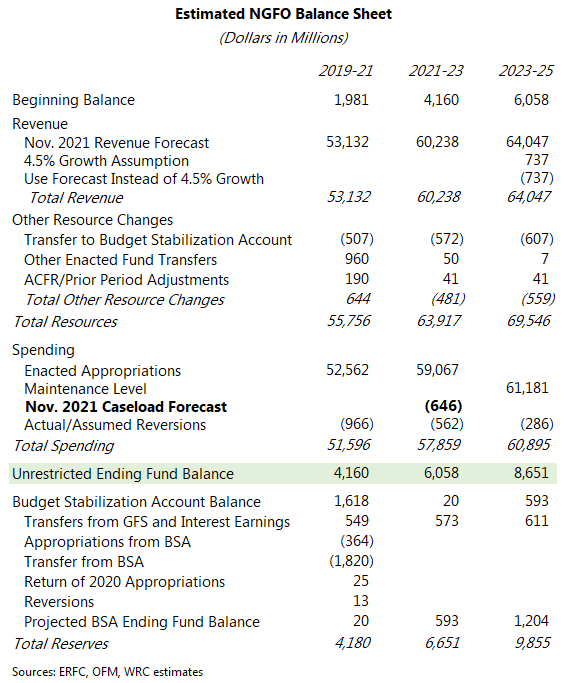10:39 am
November 24, 2021
As I noted yesterday, the state has an estimated $7.356 billion more in revenues from funds subject to the outlook (NGFO) than was expected at the end of the 2021 legislative session. Additionally, the November caseload forecast indicates that the cost of continuing current services for this biennium will be $645.8 million less than expected when the current budget was written.
The Economic and Revenue Forecast Council (ERFC) won’t produce an official budget outlook until January, which will incorporate the governor’s 2022 supplemental budget proposal. However, the revenue forecast includes an updated balance sheet for 2019–21 (which ended June 30) and 2021–23 (the current biennium). This includes the new revenue forecast and provides some final accounting information for 2019–21. I’ve used this information to estimate the outlook for 2023–25.
The most noteworthy accounting adjustment has to do with reversions, which are appropriations that are not actually spent. The ERFC typically assumes that reversions will total 0.5% of general fund–state (GFS) appropriations. According to the June outlook, that means reversions of $125 million in FY 2021, $281 million in 2021–23, and $286 million in 2023–25. On top of that, since June 2019, the outlook has included additional reversions related to K–3 class size compliance for 2019–21 and 2021–23. (As of Sept. 1, 2019, state funding for lower K–3 class sizes is tied to schools’ actual K–3 class sizes. Districts have not fully complied yet.) The June outlook assumed that the K–3 reversions will be $35 million in FY 2021 and $15 million in 2021–23.
Additionally, Gov. Inslee imposed several saving measures in 2020 related to the pandemic, and increased federal funds took the place of some state spending last year. This increased reversions substantially in 2019–21. The June outlook assumed that reversions would be $700 million in 2019–21 and $296 million in 2021–23. The November revenue forecast indicates that actual 2019–21 reversions were $965.9 million. It estimates that 2021–23 reversions will be $561.9 million.
The 2021–23 figure includes $266.2 million in GFS savings where the Office of Financial Management (OFM) was able to use federal relief funds in lieu of the GFS. (Sec. 753 of the 2021–23 operating budget gave OFM the authority to use Washington’s share of the coronavirus relief fund for eligible costs instead of other fund sources, in order to use up those federal dollars before they expire.)
Given the increased revenue forecast, increased reversions (i.e., decreased spending), and the decreased caseload forecast, I estimate that at the end of the outlook period the unrestricted NGFO ending balance is $8.651 billion. The ending balance for the budget stabilization account (BSA, or the rainy day fund) is estimated to be $1.204 billion.
Note that the estimated outlook does not include the $1 billion the Legislature stashed in a shadow reserve account. Additionally, the state has $1.273 billion left of its share of the coronavirus state fiscal recovery fund.
On the other side of the ledger, the estimated outlook does not include any new policy items the Legislature may choose to fund in the upcoming session. A few potential big-ticket items that I’ve noted previously are K–12 enrollment stabilization and collective bargaining agreements with state employees.

Tags: 2021-23
